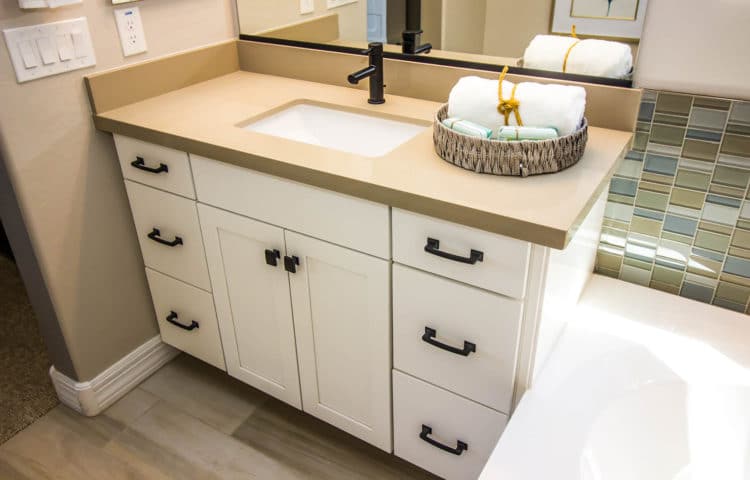When you’re looking to upgrade your home, one place that will make a big difference is with your baseboards. Some people use wood baseboards while others use tile.
But is one better than the other?
That depends on a few different things and since there are so many options, you may feel dizzy over the decision.
Focusing on wood or tile baseboards in the bathroom, you could even consider the tiles that look like wood to keep up an aesthetic.
The most important thing though is how you need those baseboards to function. Wood is a popular choice, especially in living rooms and bedrooms.
But it is also used in a bathroom too. However, many choose tiles in this space for easier care, cleaning, and maintenance.
Keep reading to find out more about whether you should choose wood or tile baseboards for your bathrooms!
Wood or Tile Baseboard in Bathrooms?
Choosing from wood or tile baseboards in the bathroom requires deciding on other important factors. Along with price, ease of maintenance and cleaning plus longevity should be on your mind. There is no one right choice though the benefits of one may prove better for you than another.
When it comes to wood or tile baseboards in the bathroom, you will need to consider the pros and cons of each material.
The right choice can make all the difference in how your home looks, giving it a fresh new look and feel.
What are wooden baseboards?
Wooden baseboards are most common in living rooms and bedrooms, but they are used in bathrooms too. Wood-based flooring benefits with re-staining and can be fixed with ease if you crack them. They are easy to replace when they are worn out too.
You can also save a bundle if you DIY, however, wood baseboards tend to look good with wood floors.
You can get around that with paint to match your walls though. Solid wood is more expensive over pressed types, though it is more durable. It’s a good investment for your home.
What are tile baseboards?
Tile baseboards are excellent for bathrooms. They tend to be more expensive since they are made from ceramic, glass, granite, porcelain, and marble. Ceramic will be a more affordable choice from these.
They last a long time and are easy to clean, but if one cracks, you’ll need to replace it. Still, they are water and scratch resistant and they won’t get all wonky if you get them wet like wood baseboards.
Often in a bathroom setting, water can get on the baseboards. Even in a half-bath, the water can drip down when anyone dries their hands on the hand towels you have hanging in there.
That little bit of water can eventually warp and discolor wooden baseboards which you’ll have to replace.
How to choose wood or tile baseboards for your bathroom
When thinking about your options with wood or tile baseboards for the bathroom, you should consider a few key factors to help you make your decision.
– Think of functionality
In a bathroom, you have to think of the steam from the shower and splashes. In that regard, you may find that choosing tile baseboards is best here.
It’s not that you can’t find durable wood or coat it with varnish to help. But wood will take more of a beating here.
That steam and contact with water will lead to warping on the wood in time. Plus, you’ll have to think about re-staining on occasion.
Wood is very versatile and can be easily fixed up when it gets worn out though tile will last longer before it needs an upgrade.
– Consider appearance
This is usually where everyone feels overwhelmed. There are so many options and aesthetics, but you can create contemporary styles even with wood.
The over-ruling factor should be functionality and budget because you can match the appearance you’re going for with either wood or tile.
Typically, with an 8-foot wall, your baseboards should measure between 3 to 5 inches in height. For a taller ceiling at 10 feet, 5 to 7 inches is a better option. Going taller gives things a more contemporary look.
– Budget concerns
While you likely have a budget to fit, you should also think about the long-term value that this investment has for your home. Tile is certainly more expensive unless you choose the high-end woods.
However, in a bathroom, tile may be better because you will have less maintenance to keep them looking new over the years.
It’s less likely you’ll crack a tile. Also, if you’re handy, you can do it all yourself which means you’ll save on the costs of labor.
Pros and Cons of Wood Baseboards for Your Bathroom
Still on the fence about which material to use for your baseboards in your bathrooms? Wood can be painted with water-resistant materials to make it more durable for a steamy, wet environment. But still, this can impact the wood over the years.
Wood is generally recommended for dry rooms in your home – the living room, bedrooms, study, hallways, and den. These rooms don’t have water or steam in them, making it a better place for wood.
Wood is one of the best options because it is versatile. However, in bathrooms, they get worn out and swell up.
When that happens, you will have to think of the repairs you’ll need to make to restore your original look.
Pros and Cons of Tile Baseboards in Your Bathroom
For your bathroom, tiles may be best. They are durable, resistant to scratches and water, and it’s much harder to damage them. The downside though is that they can cost much more.
However, that higher upfront expensive saves you on repairs down the road. It’s less likely you’ll be replacing them in a few more years or making repairs to damages from water.
Tiles were made for bathrooms. They naturally fit the texture and go with the tiles you have in there and they have a greater longevity that will make it easier to keep up with the look of your home.
Installing wood baseboards
So, now that you know about the pros and cons of wood and tile baseboards, here’s how you can install them yourself. We’ll start with wood first!
Step 1: Nail the plywood
To get that wood baseboard to your wall, you’ll need a PL adhesive glue and plywood that is the same size as your wall tile.
You will glue that strip onto the wall where the baseboard will go. This will be the filler between the wall tile and the baseboard.
When you glue it on, nail the top edging of the plywood. Then nail the baseboard on the filler strip, making sure it is completely covered by your baseboard. It shouldn’t be visible.
Step 2: Position the baseboard
Go with over the tile to avoid having to cut your tiles in an even shape. If you have uneven edges, that baseboard won’t reveal it with this. It will cover the uneven edges behind it.
This is the easiest way to have a beautiful wall tile and baseboard with less effort.
If you have decided to place your baseboard over the tile, you don’t need to join the edges. These will stay free and you can make changes more easily.
Now, if you want to make the baseboard meet the tile by joining it, you can do that too though the edges must be cut evenly or it will look sloppy.
Additionally, when joining the tile and baseboard, you need to caulk the baseboard to the tile.
If you don’t, then the floor will have a tented look, lifting and expanding to create an unsightly appearance that you may need to call in professional help to remedy.
Step 3: Filling the gap
Ideally, your wall and tile will have a gap of ¼-inch. Put the baseboard over the tile and then you won’t need to fill in the gap between them.
If not, the gap needs to be filled. You can use grout to do that. Silicone is another way which is very effective for wooden baseboards.
Additionally, silicone can also keep bugs away, another reason to use it.
Step 4: Adjusting the extra space
If there is too much space between your tile and baseboard, you have to adjust the gap. You can bevel the baseboard edges. A table saw and Dremel tool can help with that to fix the gap.
Installing Tile Baseboards
When you install tile baseboards, you’ll have more longevity. You won’t have to worry about water or steam impacting the integrity of them. Tile baseboards aren’t all that difficult to install either.
The steps below can help you DIY!
Step 1: Cut your tiles
Measure the height for your baseboard and mark the tile. Then, using a tile saw, cut. You will get 2 tile baseboards out of every floor tile you cut in this fashion.
Step 2: Prepare your walls
Once you’ve measured and cut, clean your walls to remove dust, grout, or any other debris from the walls. Vacuum it up too so nothing stands in your way of a proper installation.
Step 3: Put on acrylic mastic
You’ll now want to smear the acrylic mastic on the bottom part of the walls where you’ll be installing those tiles. Do this with a v-notch trowel.
But do NOT smear this on the entire wall base all at once. It’s better to apply it in an area you can cover and place the tiles on rather than letting it dry out on there before you get the tiles on.
Don’t spread wider than you can go or you’ll make a mess and create more work for yourself.
Step 4: Install your tiles
Press your cut tiles into that acrylic mastic. Use the tile spacers you used to install the flooring tiles between the tile baseboards. This is so you get grout lines even and lined up with the flooring tiles.
Additionally, between the floor and tile baseboard, put a 2 ¼-inch spacer under each tile flat. Now let this all air dry and set for a minimum of 24 hours.
Step 5: Add the grout
Once everything has dried in place, you can remove those spacers. Then you’ll mix the grout so it resembles peanut butter and apply it, forcing it onto the grout lines between these tiles by using a grout trowel.
Wipe off any excess from the tiles using a damp sponge. Now you’ll let this set undisturbed for a minimum of 72 hours.
Step 6: Seal it
Now that you’ve let the grout set, you can add grout sealer. It’s best to apply 2 to 3 layers of it. This protects your grout from cracking and seals the deal with your tile baseboards for the perfect finish!
Conclusion
If you’re considering redoing your bathroom baseboards, you’re likely trying to decide between using wood or tile. Both are quality materials with a variety of looks, styles, and wearability.
However, for a bathroom, you’ll have the least maintenance on tile baseboards. These can stand up to steam and water without warping. Tile does tend to cost more but you’ll wind up saving in the long run by not having to replace them.
Wood can be treated to resist water though in time, it will still buckle. It’s up to your tastes and budget as to which one you’ll ultimately go with.
If you’re handy, you can install either type yourself. Or you may find it best to hire a professional to tackle this hard work.
Either way, knowing more about the process, the materials, and how they will hold up in each setting will make it easier for you to decide on which you want to use and help you upgrade your bathroom to match the style you’ve always envisioned it to hold.

